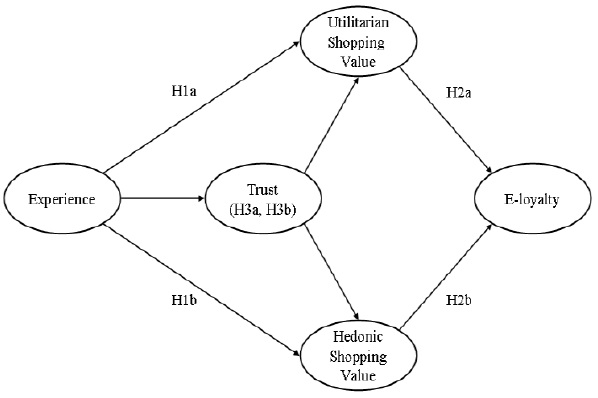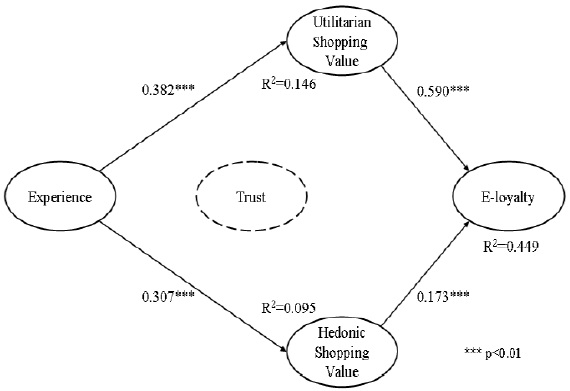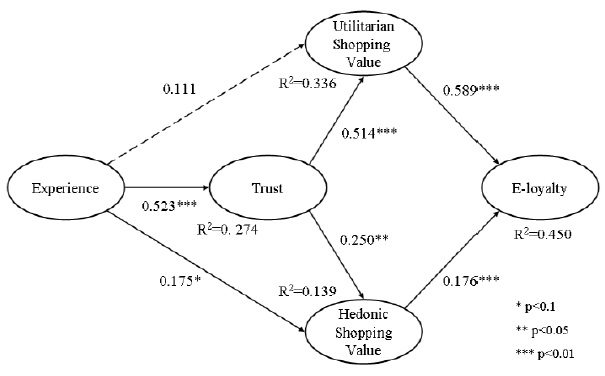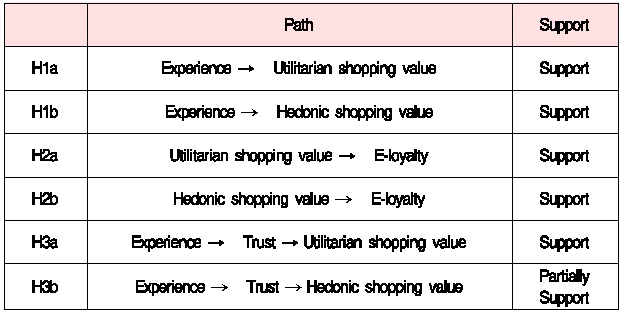


본 연구는 쇼핑경험과 쇼핑가치 간의 관계에서 매개변수로서의 신뢰의 중요성을 파악하는 데에 주된 목적을 두고 있다. 쇼핑의 효용적 가치와 쾌락적 가치에 대한 기존 연구는 선행변수나 결과에 주로 초점을 두고 있는 것이 많다. 또한, 신뢰의 역할이 온라인 쇼핑몰에 관한 논문에서 많이 연구되어 온 것은 사실이나, 대부분 쇼핑 내지는 사용 의도와의 관계에 치중되어 왔고, 소비자가 쇼핑가치를 갖게 되는 메커니즘에 대한 연구는 그리 많지 않았다. 본 연구는 신뢰가 어떻게 쇼핑의 효용적 가치나 쾌락적 가치를 증가시킬 수 있는가에 대해 초점을 두고 있으며, 이러한 연구는 쇼핑몰에 대한 소비자의 충성도와 깊은 관련이 있는 만큼 중요한 사안이라 할 수 있다. 구조방정식 모형이 제시되었고, 서베이를 통하여 신뢰의 역할을 실증적으로 검증하였는데, 신뢰를 매개변수로 포함한 모형과 포함하지 않은 모형을 비교함으로써 매개효과를 파악하고자 하였다. 그 결과, 신뢰가 쇼핑 경험과 쇼핑 가치의 관계에 매우 강하게 매개 역할을 하고 있음을 알 수 있었다.
When consumers purchase product or service, they wish to gain full information related to all the process of the purchase (Choe, Hwang, Kim & Moon, 2007). However they can’t obtain right and sufficient information whenever and wherever they want. Then consumers may rely on their previous experiences (Jarvenpaa & Todd, 1996-1997). In the context of e-commerce, the tendency will be greater than offline trade since there exists information asymmetry which works as a generator of perceived risk. In the perspective of risk mitigator, a number of studies have been conducted on the role of experience toward purchase behavior in online shopping sites (e.g. Jarvenpaa & Todd, 1996-1997; Novak, Hoffman & Duhachek, 2003). The findings verify that experienced online consumers may expose different degrees of their risk perceptions. Consequently, the role of past experiences is emphasized for consumers to reduce the level of perceived risk and boost their confidence. The reason why revious experience is associated with trust is that trust is built up by the accumulation of positive experience (Lewicki, McAllister & Bies, 1998). Trust is a kind of function between experience and a vendor. Therefore, consumers initially rely on their own decision-making criteria but when they have the benefit of experience, knowledge from the experience plays a bigger role than other factors(Novak et al. 2003).
With regard to influences on online consumer purchase behavior, shopping value may have just as significant a relationship as the experience factor because it has a greater impact on evaluation or consideration conducted in the context of purchase behavior by consumers (Hirschman & Holbrook, 1982; Babin, Darden & Griffin, 1994; Hammond, McWilliam & Narholz, 1998). Studies on the relationship between the degree of experience and shopping values show that shopping values emphasized by consumers change with the level of experience (Brucks, 1985; Rao & Monroe, 1988; Hammond et al., 1998). Taken together, the formation of trust on online trade by increasing the level of purchase experience will drive consumers to have prior consideration on shopping value. Previous studies have been made focusing on identifying the relationship between experience and trust, trust and e-loyalty, and shopping value and e-loyalty respectively without stress on the importance of the role of trust among them (Hammond et al., 1998; Lewicki et al., 1998).
The main goal of this study is to investigate the role of trust as a mediator between shopping experience and shopping value. This study will prove the mediating role of trust by comparing the value of R2 in PLS-graph between models with and without the trust variable as a mediator. Finally several implications will be suggested by using the findings.
2.1 Experience and Shopping Value
Prior experience has been found to be an important determinant of behavior (Ajzen, 1991; Bagozzi, 1981). Especially it has been suggested that knowledge gained from past behavior will help to shape shopping intention (Fishbein & Ajzen, 1973) partly because experience makes knowledge more accessible in memory and also because past experience may make low probability events more salient ensuring that they are accounted for in the formation of intentions (Ajzen, 1980). This is also implicated in the context of the Internet. Experience related to precursors of online shopping predicts online shopping or intent to shop online. Researchers have found that previous practice affects online shopping adoption or intent to adopt (Grazioli & Jarvenpaa, 2000). Experience in this study is related to knowledge accumulated over time (Walczuch & Lundgren, 2004). This knowledge is built through active participation of the consumer in the online buying process. A measure of experience is constructed by how many times consumers purchase something from a particular e-retailer (Hammond et al., 1998; Walczuch & undgren, 2004).
Some literatures attempt to associate the level of consumer experiences with shopping values (Rao & Monroe, 1988; Titus & Everett, 1995; Hammond et al., 1998). Shopping value refers to an aspect to influence evaluation or consideration conducted in the context of consumer purchase behavior. Many researchers divide shopping values into utilitarian and hedonic aspects. The utilitarian aspect is regarded as goal-oriented and relates to usefulness, value, and cleverness of the behavior as perceived by the consumer. On the other hand, the hedonic aspect results from esthetic/emotional feelings and relates to pleasure, fun or playfulness experienced or anticipated from the behavior (Hirschman & Holbrook 1982; Hirschman & Solomon, 1984). Integrating the degree of consumer experiences with shopping values, researchers claim that shopping experience influences the aspect of the shopping values emphasized by consumers. Rao & Monroe (1988) empirically prove that people with high product familiarity utilize utilitarian (intrinsic) cues while people with low familiarity utilize image-related (extrinsic) cues. Moreover Hammond et al. (1998) created a matrix to explain the relationship between web values and the degree of experience of the Internet. Table 1 summarizes the fact that highly experienced users emphasize a utilitarian dimension rather than a hedonic dimension while less experienced users emphasize hedonic rather than utilitarian.
[Table 1.] Hammond et al. (1998)

Hammond et al. (1998)
Utilitarian shopping value is largely associated with the logical and rational purchase strategies of consumers learned from experience and information searches (Hirschman & Holbrook, 1982; Babin et al., 1994). Experienced users gain familiarity and knowledge from their prior experiences and the outcomes of experience help the extraction and comprehension of relevant information and play important factors in determining what sorts of activities consumers are involved in (Titus & Everett, 1995; Hammond et al., 1998). Gefen, Karahanna & Straub (2003) also implicitly addressed that direct experiences with online purchases lead to more informed and confident assessment of the online exchanges, resulting in increasing utilitarian dimensions of consumr value. The ground of this consequence seems to be that with experience consumers overcome concerns on online transactions and focus their attention on their utilitarian purpose of shopping-acquisition of particular product or service (O'Curry & Strahilevitz, 2001). Hence we posit the following hypothesis.
Although Hammond et al. (1998) asserted that experienced users consider entertainment value at a lower level, their empirical test proved that experienced users did not perceive entertainment value as less than those with only a little experience. This means that once consumers repeatedly experience positive emotions such as pleasure and arousal from previous shopping activities, consumers’ hedonic values like fun or entertainment is increased or at least maintained at the same level as at the first stage of shopping experience. This output may result from repetition or familiarity with the process of purchasing. When consumers first interact with an online shopping, they generally feel intimidated and stressed, and consequently the level of their playfulness and enjoyment is low (Thompson, Higgins & Howell, 1994). As they attain some level of familiarity with online trades over time, they are more likely to explore the process and interact with it. That is to say, repetition or familiarity with online vendors or their site reduces perceived risk which prevents users from enjoying pleasure or fun during shopping (Hirschman & Holbrook 1982; Babin et al., 1994; Heijden et al., 2003). This is in line with the findings that development of computer experience over time has been shown to be effective in reducing computer anxiety and there was a strong correlation between computer experience and users’ hedonic value (Webster & Martocchio, 1992). Therefore, positive repeated experience will be related to hedonic shopping value in the context of online shopping.
2.2 Shopping Value and E-Loyalty
Studies in cognition and decision-making show that when consumers are faced with a choice of tasks, it is thought that they search for reasons and arguments to justify their choice (Dhar & Wertenbroch, 2000). Those decision situations that foster justification and rationale for the choices made are more likely to see their utilitarian aspects emphasized. Consumers faced with a goal-directed decision that requires action and effort to accomplish need more justification and reasoning to substantiate their decision.
Related research suggests that the utilitarian aspects of decisions are likely to be emphasized when consumers feel they will have a higher probability of future success in acquiring a particular product (O'Curry & Strahilevitz, 2001). Higher utilitarian value implies past success at product or information acquisition, and is likely to affect shoppers’ assessment of the probability of acquiring the same or similar products in the future. Shoppers are likely to emphasize the utilitarian value of the shopping experience. As a result, utilitarian value is likely to be more strongly related to shopping outcomes such as purchase intentions than hedonic value.
In this research, e-loyalty which includes revisiting intention, word of mouth and assent on other’s purchase will be adopted as retail-related outcomes. e-loyalty refers to the customer’s favorable attitude towards an electronic business, resulting in repeat visiting and buying behavior (Srinivasan, Anderson & Ponnavolu, 2002). e-loyalty is used as dependent variable in various studies dealing with internet shopping mall because it is likely to give birth to success of e-commercial business.
Many researchers suggest hedonic shopping value should also be emphasized because hedonic value influences consumers’ purchase behavior. For example, Dawson, Bloch & Ridgway (1990) claim hedonic value significantly influences repurchase intention in the context of offline market. In the case of online shopping, consumers consider the hedonic value very important. Therefore, it is inferred that hedonic shopping value has positive relationship on e-loyalty (Novaketal, 2003).
2.3 The Mediation Role of Trust in the Experience-Shopping Value Relationship
Hammond et al. (1998) tried to present that the degree of shopping experience changes the aspect of the shopping values emphasized by individual. Other researchers also support their assertion. Hirshchman & Holbrook (1982) and Babin et al. (1994) described that experience and utilitarian shopping value have a correlation by mentioning that consumers usually rely on their experiences and they utilize them for consumers’ logical and rational purchase strategies. With a regard to the relationship between experience and hedonic shopping value, researchers claimed that experienced shoppers will enjoy pleasure and fun because knowledge and familiarity from repeated purchases reduce perceived risk and uncertainty as well (Hirschman & Holbrook 1982; Babin et al., 1994; Heijden et al., 2003).
Looking closely at the stream of experience and shopping value, we can find that there exists trust to connect the two variables. Trust is defined as willingness to rely on a partner in whom one has confidence based on belief in that party’s credibility and benevolence in an environment characterized by uncertainty (McKnight & Chervany, 2002). Consequently trust plays a role to reduce the level of uncertainty through interactive communication and activities and crucial in many buyer-seller relationships, especially those containing an element of risk (Reichheld & Schefter, 2000; Pavlou, Liang & Xue, 2007).
Therefore we posit that a study should be conducted on the role of trust between experience and shopping value to more closely scrutinize the flow of experience to shopping value. In other words, trust is proposed to mediate experience and shopping value. To support this proposition, firstly we adopt Sirdeshmukh, Singh & Sabol (2002) study that associated trust and consumer’s value in the aspect of experience, trust and utilitarian shopping value. Trust creates values by providing relational benefits derived from interacting with a trustful provider, helping consumers to form consistent and reliable expectations of the provider. In other words, if consumers perceive a higher level of risk, they will not only carry out a higher level of purchase decisions, but also spend more time and effort searching for information. Taken together, it is inferred that a high level of trust derived from repeated experiences can reduce the overall cost and time of navigating online shopping sites by decreasing the degree of exchange uncertainty. This efficient and rational consumer behavior is related to utilitarian consumer behavior (Hoffman & Novak, 1996). Based on these facts, we posit that utilitarian value is indirectly influenced by experience in a flow where trust plays a mediating role between them.
Secondly on the flow of experience to hedonic value, trust also seems to work as a crucial factor. Repetition or familiarity through past shopping activities lesson perceived uncertainty and consumers are exposed to such an environment to enjoy more pleasure or fun during a shopping process (Hirschman & Holbrook 1982; Babin et al., 1994; Heijden et al., 2003). That is to say, consumers’ hedonic shopping value will increase as consumers repeat their purchases, accumulating knowledge and familiarity on shopping activities when trust is built to abate uncertainty and complexity (Jones & George, 1998). Therefore we can infer that the experience influences hedonic value when trust works as a mediator between them.
Through the proposed model Figure 1, we examine the hypothesis that consumer trust is a mediating variable between purchase experience and shopping value as well as between shopping value and e-loyalty. This model includes the six hypothesis stated above. Based on the relationship between experience and shopping value, trust is introduced as a mediator and e-loyalty as a dependent variable.
There is a study that is similar to Figure 1. Na (2010) modeled and empirically showed that hedonic and utilitarian value had a notable effect on shopping-mall trust. However, Na examined the relationships between shopping values and shopping-mall trust while this study tries to examine the role of trust pertaining to experience.
In this study, it was decided to collect data through a survey to verify the study model hypothesis proposed in Table 2. In order to draw up adequate survey questions, we carried out literature review and constructed the survey questions listed in Table 2. Each question is measured based on a 7-point scale.
[Table 2.] Questionnaire design
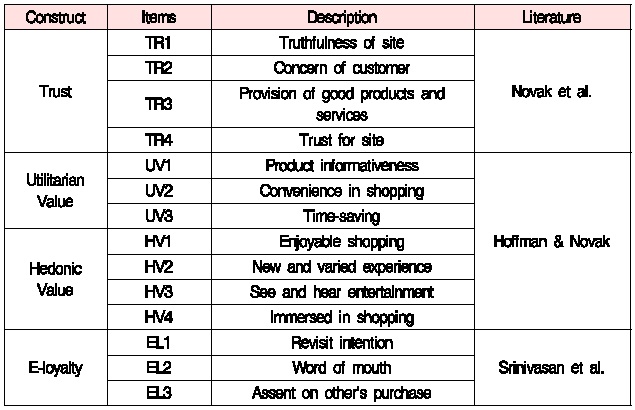
Questionnaire design
4.1 Data Collection and Method
To conduct an empirical analysis, 400 copies of the survey were distributed targeting subjects who have purchase experiences through online sites, of which 330 were retrieved. Respondents were required to answer for a particular online shopping mall through which they purchase goods most frequently. Except for those that could not be used, 321 final samples were used for the analysis. Of the responders, 43.9% were male (141 people) and 56.1% were female (180people). Average age of the responders was 32.1 and most of them graduated as undergraduate or graduates. The annual rate of purchasing goods through online shopping sites is in the following order: 2~4 times (37.4%), 5~7 times (22.1%), over 11 times (14.9%), below once (13.1%), and 8~10 times (12.5%).
To perform our analysis we used a Partial least Square and Structural Equation Modeling tool (PLS-graph). PLS is a structural equation modeling technique that can analyze structural equation models (SEM) involving multiple-item constructs. PLS is a very useful analysis tool under conditions of non-normality and relatively small to medium sample sizes (Chin, 1998).
4.2.1 Internal Consistency
[Table 3.] Convergent validity and internal consistency
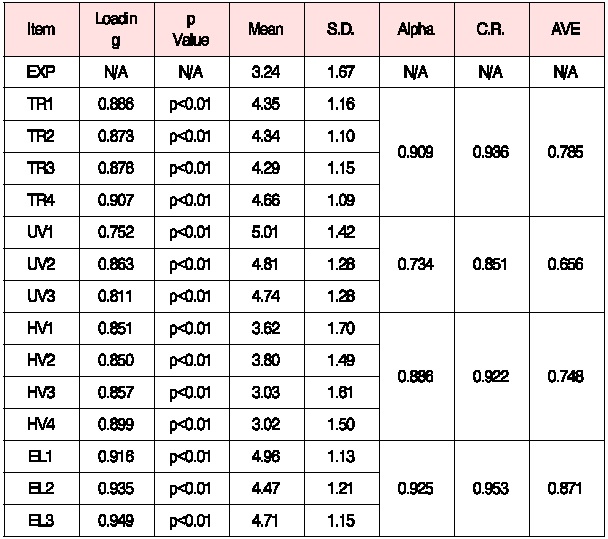
Convergent validity and internal consistency
We performed our validation by constructing a PLS model. In order to perform our validation, internal consistency (reliability) was examined through Cronbach's
4.2.2 Convergent Validlty and Discriminat Validity
We conducted composite reliability (CR) to verify convergent validity and discriminant validity. Values greater than 0.70 in CR imply that a construct retains both its internal consistency and convergent validity (Werts, Lin & Joreskog, 1974).
The factor loading and Average Variance Extracted (AVE) were also examined to determine the convergent validity. The AVE measures the percentage of variance captured by a construct by showing the ratio of the sum of the variable captured by the construct and measurement variance. The criteria for the acceptable level of convergent validity is individual item factor loading greater than 0.60 and an AVE greater than 0.50 (Gefen, Straub & Boudreau, 2000). Table 3 summarizes the factor loadings, CR and AVE of the group. All factor loadings, CR and AVE in this measurement model turned out to be acceptable.
[Table 4.] Cross-loading table
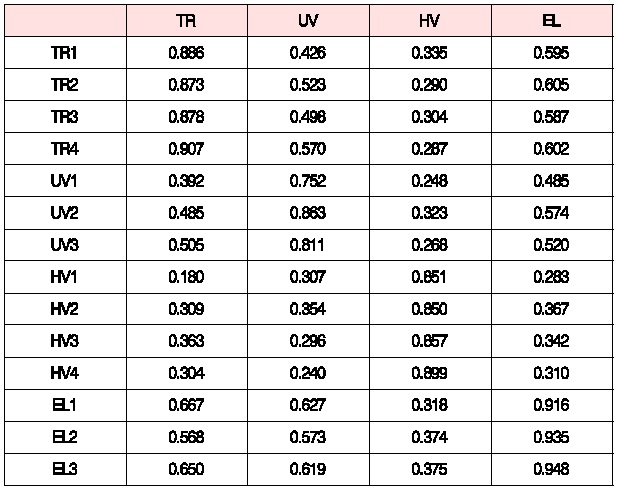
Cross-loading table
To verify discriminant validity, the cross-loading analysis and AVE square root analysis were conducted. As can be seen in the cross-loading table in Table 4, all loading of construct of latent variable was over 0.7 and all factors loading was significant at confidence level 0.01. Furthermore, as for the other construct, the loading was below 0.7. This hows that measurement has discriminant validity.
If the AVE square root value is higher than the other correlations of verticals and horizontal, it proves that discriminant validity of measurement of this study has been ensured. As can be seen in Table 5, all correlations among latent variables and AVE square root value have been found.
[Table 5.] Correlaions of the latnt variables and the square root of the AVE
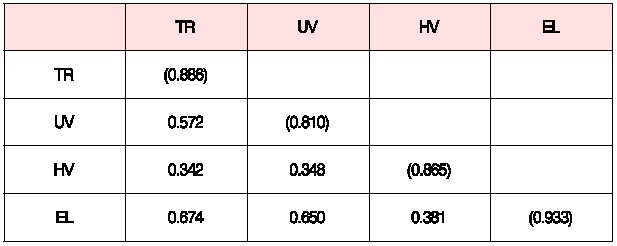
Correlaions of the latnt variables and the square root of the AVE
This study was conducted to examine the hypothesis that trust plays a mediating role between experience and shopping value as well as determining that there are positive relationships between experience, shopping value, and e-loyalty.
Firstly, Figure 2 and 3 is the result of analysis of the study model using PLS based on hypothesis constructed in this study, which represents path coefficient and R2 value according to each condition (i.e., without and with mediator). According to Figure 2, experience shows a significant influence on both utilitarian value and hedonic value at confidence level of 0.01. This result supports H1a and H1b.
In without mediator model, utilitarian and hedonic shopping value influence e-loyalty significantly at confidence level of 0.01 respectively. This finding supports H2a and H2b as well. E-loyalty is explained as 45% by two shopping variables but they are not equal in strength. The result highlights that the main contribution to e-loyalty is due to utilitarian value (0.589) rather than hedonic value (0.176).
However, in spite of a significant impact of experience on shopping value, utilitarian aspect is found to be explained as 14.6% while hedonic aspect is 9.5%. It suggests that experience factor does not provide a substantial explanation for the perceptions of shopping value and other variables must need to be found to describe shopping value.
4.4 Testing the Mediating Role of Trust
In general, mediation hypothesis are tested using a statistical technique suggested by Baron and Kenny (1986). To claim that a given variable may function as a mediator (M), the following conditions must hold in order to establish mediation: [1] a significant relationship exists between the independent variable [X] and the dependent variable [Y]: [2] a significant relationship exists between X and M: and [3] in the presence of a significant relationship between M and Y, the previous significant relationship between X and Y is no longer significant or the strength of the relationship is significantly decreased.
Moreover, if all of the significant variance of that relationship is accounted for by the direct effect from M to Y, the relationship between X and Y is fully mediated. That is, the influence of X on Y is adequately captured as an indirect influence through M and the observed association between X and Y is accurately captured by tracing the pathways from Y back to M and from M back to X. However, a partially mediated relationship refers to the state if the direct effect of the mediator M accounts for a significant amount of variance in Y, but path coefficient from X to Y remains significant. Finally, if path coefficient from M to Y is insignificant when path coefficient from X to Y is present in the model, then no mediation is evident (Little, Bovaird & Card, 2007). The proposed mediation hypothesis in this study were tested using the criteria mentioned above in the context of PLS-graph analysis where R2 was used to verify the effect of a mediator(Burton-Jones & Hubona, 2006).
According to the theory mentioned above, Figure 3 shows there is a significant mediated effect in the model. Firstly, the relationship between experience and utilitarian value is fully mediated. While the relationship between experience and utilitarian value is not strongly related (t=1.32), path coefficient between trust and utilitarian value (t=6.23) as well as experience and trust (t=8.34) remains significant at confidence level of 0.01: on the other hand, a partially mediated relationship is found between experience and hedonic value. Experience and trust significantly influences hedonic value at confidence of 0.1 (t=1.71) and 0.01 (t=2.55), respectively. That is, path coefficient from experience and hedonic value not only remains significant, but also the direct effect of the mediator explains a significant amount of variance in hedonic value. That is, path coefficient from experience and hedonic value not only remains significant, but also the direct effect of the mediator explains a significant amount of variance in hedonic value. The results are summarized in Table 6.
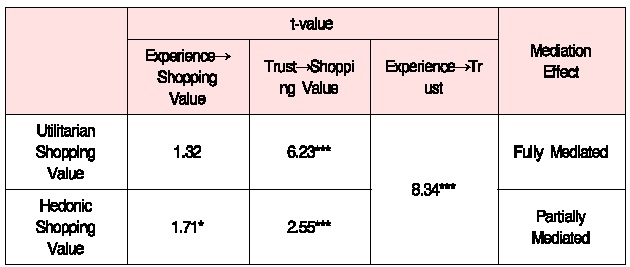
Summary of results
Furthermore, the comparison of the results of a model without a mediator and the one with a mediator provides a clearer insight into the understating of the mediating role of trust. Table 7 shows the change in R2 resulting from introducing a mediator. In the case of utilitarian value, introducing the mediator (trust) dramatically increases the R2 from 0.146 to 0.336 by 130.1%, while the R2 in the case of hedonic value is increased by the mediating effect of trust from 0.095 to 0.139 by 46.3%. The overall findings, therefore, provide a strong support to the study’s hypothesis H3a and H3b.

Cornparison of R2
However, although trust had a significant relationship with both utilitarian and hedonic value, the power that trust exercises on two variables is different. The value of path coefficient from trust to utilitarian value roughly doubles that from trust to hedonic value. This suggests that as trust increases, consumers’ utilitarian value responds more sensitively than hedonic value. Also, the explained variance in hedonic value is quite low (R2=0.139). Therefore, some relationships may reflect greater statistical significance than practical, significance (Burton-Jones & Hubona, 2006).
[Table 8.] Result of hypothesis test

Result of hypothesis test
This study was conducted to examine the factors that influence e-loyalty of online shoppers in the point of experience and shopping value. Based on literature review, we posited trust as a mediator in the relationship of experience and shopping value. We also examined the significant effect of shopping value to e-loyalty through PLS analysis.
Results provide several key findings that were validated with the two different models. Above all, we found the mediated effect in the model where trust linked experience and shopping value. In the case of utilitarian shopping value, trust worked as a full mediator. The significance between experience and utilitarian value disappeared when trust worked as a mediator between them. On the other hand, a partially mediated effect existed among experience and hedonic value in the existence of trust. Hedonic value was directly linked with the mediator (p<0.05) and experience (p<0.1). Secondly, we verified a direct effect between shopping value and e-loyalty. Utilitarian and hedonic shopping value significantly influences e-loyalty at confidence level of 0.01. However, the value of path coefficient from utilitarian value to e-loyalty (0.589) is much bigger than hedonic value (0.176) in the mediated model. This result, therefore, proposes that e-loyalty will be more sensitive to utilitarian value than hedonic value.
The main theoretical contribution of this research is that this research provides the integrated and systematic aspect with a regard to experience, shopping value, and e-loyalty. We substantiated the mediating role of trust in the relationship between experience and shopping value in e-commerce literature (Hammond et al., 1998; Sirdeshmukh et al., 2002). Particularly we identified the relationship between trust and hedonic value. This proposes that according to the flow theory, consumers who are in a flow state tend to enjoy their online experience more within the interactive environment (Hoffman & Novak, 1996). Therefore, interaction with a vendor built through previous experiences will create trust which consequently influences hedonic value. Secondly, the main path is found from experience to e-loyalty via trust and utilitarian value. The values of path coefficient between the variables with utilitarian value are greater than those with hedonic value, suggesting that the variables interact with utilitarian value more sensitively. In other words, more experiences reduce uncertainty and perceived risk through building trust so that consumers feel more confident and better able to achieve their intrinsic goals in online shopping.
Suggestions in a practical dimension are as follows. First, since shopping value is not directly influenced by experience but by trust mediating experience and shopping value in the context of B2C e-commerce, it is essential to help consumers to have more satisfied experiences to increase the level of trust. Consequently, commercial websites should try to mitigate uncertainty by enhancing their trustworthiness, providing informative content, clearly describing their products and, providing a sense of social presence (Pavlou et al, 2007). Second, marketers should make an effort to provide more convenient and efficient shopping circumstances with useful and reliable information to meet the needs and values of experienced consumers. Also, various plans like time-saving services should be employed to increase the rate of repurchase and revisit. In addition, tactics such as sales promotion or price discounts should be utilized for consumers to make real and active purchases. Such strategies will encourage people to have more purchase experiences that would stimulate utilitarian value at a higher rate.
This paper, however, has several limitations. Since we simplified the model, only trust factor was infused as a single mediator in this study. Experience is also associated with perceived risk and uncertainty and trust has strong relationship with other variables such as interactivity (Teo, Oh, Liu & Wei, 2003) and information asymmetry and fear of seller opportunism (Pavlou et al., 2007). Therefore future studies are recommended to include those variables as well as covariates like sex and age. Because of these limitations, future research could experiment with an extended model with essential variables like perceived risk and attitude to examine the relationship among variables and their mediated effect, if any. Furthermore since there might be a difference in decision making on e-shopping between men and women, it will be worth the test to identify the significant difference by checking out the interaction effect of sex in the model. Lastly, this paper does not take the formation of trust into account. According to Yang et al. (2007), initial trust online consumers have towards e-shopping mall affects e-loyalty. Better results would have been expected if initial trust had been considered in the model.

